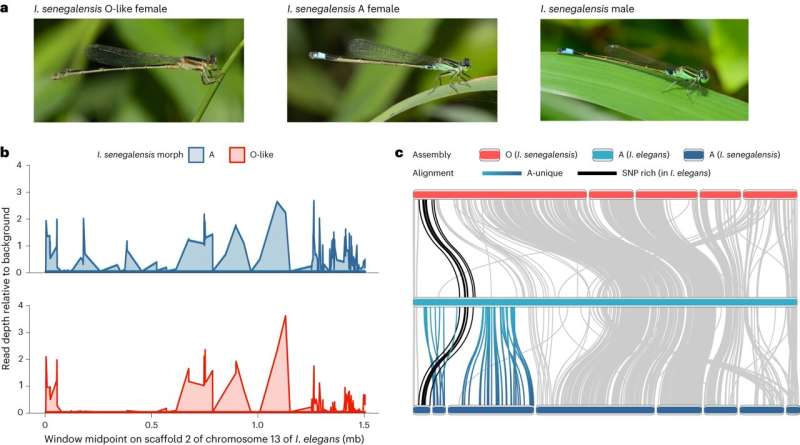This article has been reviewed according to Science X's editorial process and policies. Editors have highlighted the following attributes while ensuring the content's credibility:
fact-checked
peer-reviewed publication
trusted source
proofread
Scientists claim to have solved the damselfly color mystery

For more than 20 years, a research team at Lund University in Sweden has studied the common bluetail damselfly. Females occur in three different color forms—one with a male-like appearance, something that protects them from mating harassment. In a new study, an international research team found that this genetic color variation that is shared among several species arose through changes in a specific genomic region at least 5 million years ago.
The question of how and why genetic variation arises and is maintained over long periods of time is of key importance to evolutionary biology, population genetics and conservation biology. In all populations of limited size, genetic variation is lost over time. It is therefore important to understand both the mechanisms that give rise to new genetic variation and the mechanisms that act to maintain variation. This has significance both for conservating species and for the future evolutionary potential of populations to adapt to rapidly changing environments.
In a new study published in Nature Ecology and Evolution, a research team mapped the extensive and striking color variation among the females of the bluetail damselfly (Ischnura elegans).
"In this damselfly species, there are three genetically determined color forms in the females, one of which makes them look like males. These male-like females have an advantage because they avoid excessive mating harassment from the males. Our study clarifies when, how and why this variation arose, and shows that this variation has been maintained over long evolutionary time periods through so-called balanced natural selection," says Erik Svensson, biology professor at Lund University.
By sequencing the DNA of the three color forms of the bluetail damselfly and comparing it to the two color forms in its closely related tropical relative Ischnura senegalensis, the researchers were able to demonstrate that this genetic color variation in females arose at least 5 million years ago; through several different mutations in a specific genetic region on the damselfly's 13th chromosome.
"The great color variation in insects fascinates the general public, and raises questions about the function of color signals and its evolutionary consequences for partner choice and conflicts between the sexes," says Svensson.
Having located the gene behind the female color variation, the researchers can now go further and identify different genotypes in the males, and in the aquatic larval stage of these insects. The males lack visible color forms, but the researchers plan to investigate whether the color gene affects other characteristics of the larvae and males, including survival and behaviors.
"We now have a good knowledge base for investigating the color variation over longer evolutionary time scales among other species of this damselfly genus, which occurs in Europe, Africa, Asia, Australia, North and South America. These new genetic results help us understand both the evolutionary processes that take place within a species, and what happens over longer evolutionary macroevolutionary time scales of tens of millions of years and across several different species," concludes Svensson.
More information: Beatriz Willink et al, The genomics and evolution of inter-sexual mimicry and female-limited polymorphisms in damselflies, Nature Ecology & Evolution (2023). DOI: 10.1038/s41559-023-02243-1
Journal information: Nature Ecology & Evolution
Provided by Lund University





















